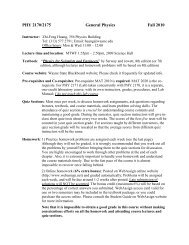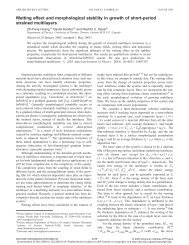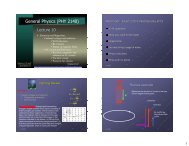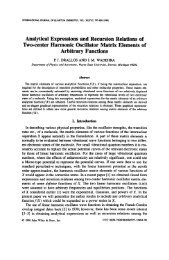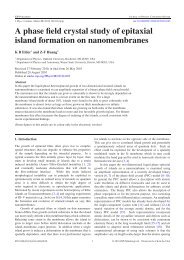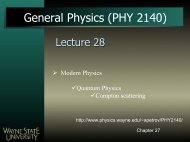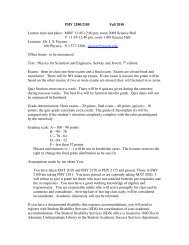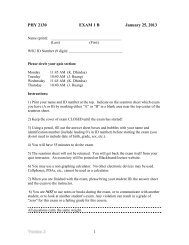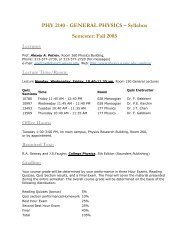pdf file
pdf file
pdf file
Create successful ePaper yourself
Turn your PDF publications into a flip-book with our unique Google optimized e-Paper software.
General Physics (PHY 2130)<br />
Lecture 34<br />
• Heat<br />
Heat transfer<br />
Conduction<br />
Convection<br />
Radiation<br />
http://www.physics.wayne.edu/~apetrov/PHY2130/
Lightning Review<br />
Last lecture:<br />
1. Thermal physics<br />
Heat. Specific heat and heat capacity of ideal gas.<br />
Latent heat and phase transitions<br />
Review Problem: A 75 g cube of ice at -10.0 °C is placed in 0.500 kg of water at<br />
50.0 °C in an insulating container so that no heat is lost to the environment. What<br />
will be the final temperature of this system?
Recall: Latent Heat<br />
• During a phase change, the amount of heat is given as<br />
Q = m L<br />
• L is the latent heat of the substance. Latent heat is the<br />
amount of heat per unit mass required to change the phase<br />
of a substance. The energy is used to form/break chemical<br />
bonds.<br />
• Latent means hidden or concealed<br />
• Choose a positive sign if you are adding energy to the<br />
system and a negative sign if energy is being removed from<br />
the system<br />
• Latent heat of fusion (L f ) is used for melting or freezing<br />
• Latent heat of vaporization (L v ) is used for boiling or<br />
condensing
Example: A 75 g cube of ice at -10.0 °C is placed in 0.500 kg of water at 50.0 °C<br />
in an insulating container so that no heat is lost to the environment. What will be<br />
the final temperature of this system?<br />
4<br />
To find the final temperature of the system, note that no heat is lost to the<br />
environment; the heat lost by the water is gained by the ice.<br />
0 = Q ice<br />
+Q w<br />
0 = m ice<br />
c ice<br />
ΔT + m ice<br />
L f<br />
+ m ice<br />
c ( w<br />
T f<br />
−T ) ice,i<br />
+ m w<br />
c ( w<br />
T f<br />
−T ) w,i<br />
0 = m ice<br />
c ice<br />
ΔT + m ice<br />
L f<br />
+ ( m ice<br />
+ m w )c w<br />
T f<br />
− m w<br />
c w<br />
T i<br />
0 = 27 kJ + ( m ice<br />
+ m w )c w<br />
T f<br />
−105 kJ<br />
T f<br />
= 32.4 °C
Example: Compute the heat of fusion of a substance from these data: 31.15 kJ<br />
will change 0.500 kg of the solid at 21 °C to liquid at 327 °C, the melting point.<br />
The specific heat of the solid is 0.129 kJ/kg K.<br />
5<br />
Use conservation of energy: all energy went to heat up and melt the<br />
substance:<br />
Q = mcΔT + mL f<br />
L f<br />
= Q − mcΔT<br />
m<br />
31.15kJ − 0.500kg⋅ 0.129kJ / kgK 306K<br />
=<br />
0.500kg<br />
( )<br />
= 22.8 kJ/kg
6<br />
Phase Diagram<br />
Phase diagram is a type of chart used to show conditions at<br />
which thermodynamically distinct phases can occur at<br />
equilibrium.<br />
On a phase diagram,<br />
the triple point is the<br />
set of P and T where<br />
all three phases can<br />
coexist in equilibrium.<br />
Sublimation is the process by which a solid transitions into<br />
a gas (and gas → solid).
7<br />
Phase Diagram<br />
The critical point<br />
marks the end of the<br />
vapor pressure curve.<br />
A path around this<br />
point (i.e. the path<br />
does not cross the<br />
curve) does not result<br />
in a phase transition.<br />
Past the critical point it<br />
is not possible to<br />
distinguish between<br />
the liquid and gas<br />
phases.
Methods of Heat Transfer<br />
• Need to know the rate at which energy is transferred<br />
• Need to know the mechanisms responsible for the<br />
transfer<br />
• Methods include<br />
• Conduction<br />
• Convection<br />
• Radiation
1. Conduction<br />
• The transfer can be viewed on an atomic scale<br />
• It is an exchange of energy between microscopic particles by<br />
collisions<br />
• Less energetic particles gain energy during collisions with more<br />
energetic particles<br />
• Rate of conduction depends upon the characteristics of<br />
the substance
Conduction example<br />
• The molecules vibrate<br />
about their equilibrium<br />
positions<br />
• Particles near the flame<br />
vibrate with larger<br />
amplitudes<br />
• These collide with adjacent<br />
molecules and transfer<br />
some energy<br />
• Eventually, the energy<br />
travels entirely through the<br />
rod<br />
Conduction can occur only if there is a difference<br />
in temperature between two parts of the<br />
conducting medium
Conduction<br />
• The slab allows energy<br />
to transfer from the<br />
region of higher<br />
temperature to the<br />
region of lower<br />
temperature<br />
P = Q t = kA T h<br />
−T c<br />
Δx<br />
Heat flow<br />
Thermal conductivity
Conduction<br />
• A is the cross-sectional area<br />
• Δx is the thickness of the slab<br />
or the length of a rod<br />
• P is in Watts when Q is in<br />
Joules and t is in seconds<br />
• k is the thermal conductivity of<br />
the material<br />
• Good conductors have high k<br />
values and good insulators have<br />
low k values
Home Insulation<br />
Also<br />
d<br />
ΔT = P =<br />
κA<br />
PR<br />
where R is the thermal resistance.<br />
This is convenient when heat is conducted through<br />
multiple layers because<br />
ΔT<br />
total<br />
=<br />
P<br />
n<br />
∑<br />
i=<br />
1<br />
R i<br />
.
Example: A metal rod with a diameter of 2.30 cm and a length of 1.10 m has<br />
one end immersed in ice at 0 °C and the other end in boiling water at 100 °C. If<br />
the ice melts at a rate of 1.32 grams every 175 s, what is the thermal<br />
conductivity of the metal? Assume no heat loss to the surrounding air.<br />
Q<br />
Δt<br />
ΔT<br />
d<br />
= κA<br />
c<br />
Heat is conducted to the ice at a rate of P = = κA<br />
.<br />
The heat conducted to the ice in a time period Δt is Q Δt.<br />
The heat needed to melt a given mass of ice is Q = m L ice f<br />
.<br />
Since all the heat conducted by the rod is absorbed by the ice,<br />
ΔT<br />
κA<br />
d<br />
Δt<br />
=<br />
m<br />
ice<br />
L<br />
miceLf<br />
κ = =<br />
ΔT<br />
A Δt<br />
d<br />
= 66.6 W/m K.<br />
f<br />
c<br />
ΔT<br />
d<br />
14<br />
( )( )(<br />
3<br />
0.00132 kg 1.10 m 333.7 × 10 J/kg)<br />
(<br />
−2<br />
1.15 10 m) 2<br />
π × ( 100 K)( 175 s)
Example: For a temperature difference of 20 °C, one slab of material conducts<br />
10.0 W/m 2 ; another of the same shape conducts 20.0 W/m 2 . What is the rate<br />
of heat flow per m 2 of surface when the slabs are placed side by side with a<br />
total temperature difference of 20 °C?<br />
15<br />
For each slab, the thermal resistance per square meter is<br />
ΔT<br />
20.0 K<br />
R = = = 2.00 K/W/m<br />
1 2<br />
P1<br />
10.0 W/m<br />
A<br />
R<br />
ΔT<br />
20.0 K<br />
2<br />
1.00 K/W/m .<br />
2<br />
20.0 W/m<br />
2<br />
= = =<br />
P2<br />
A<br />
When the materials are placed in series, the rate of heat flow is<br />
P<br />
=<br />
ΔT<br />
2<br />
∑<br />
i=<br />
1<br />
R<br />
i<br />
=<br />
ΔT<br />
R + R<br />
1<br />
2<br />
=<br />
2<br />
6.67 W/m .<br />
2
2. Convection<br />
• Energy transferred by the movement of a substance<br />
• When the movement results from differences in density, it is called<br />
natural conduction<br />
• When the movement is forced by a fan or a pump, it is called<br />
forced convection<br />
The rate of energy transport by convection is<br />
P<br />
=<br />
hAΔT<br />
where h is the coefficient of convection, A is a surface area, and<br />
ΔT is the temperature difference between the surface and<br />
convecting fluid.
Convection example<br />
• Air directly above the<br />
flame is warmed and<br />
expands<br />
• The density of the air<br />
decreases, and it rises<br />
• The mass of air warms<br />
the hand as it moves by<br />
• Applications:<br />
• Radiators<br />
• Cooling automobile<br />
engines
3. Radiation<br />
• Radiation does not require physical contact<br />
• All objects radiate energy continuously in the form of<br />
electromagnetic waves due to thermal vibrations of the<br />
molecules<br />
• All bodies emit electromagnetic (EM) radiation. The perfect<br />
absorber and emitter of EM radiation is called a blackbody.<br />
• Rate of radiation is given by Stefan’s Law<br />
P = σAT<br />
4<br />
where A is the surface area of the emitting body, T is its temperature, and σ =<br />
5.670×10 -8 W/m 2 K 4 is the Stefan-Boltzmann constant.
Radiation example<br />
• The electromagnetic waves carry the energy<br />
from the fire to the hands<br />
• No physical contact is necessary
Radiation equation<br />
Since an ideal blackbody does not exist, Stefan’s law is written as<br />
P = σAeT 4<br />
• P is the rate of energy transfer, in Watts<br />
• σ = 5.6696 x 10 -8 W/m 2 K 4<br />
• A is the surface area of the object<br />
• e is a constant called the emissivity<br />
• e varies from 0 to 1 (0 is for a perfect reflector and 1 is for blackbody)<br />
• T is the temperature in Kelvins
21<br />
A spectrum shows the amount of<br />
radiation emitted at a particular<br />
wavelength. For a blackbody, the<br />
peak of the spectrum is determined<br />
only by its temperature.<br />
Wien’s law<br />
λ<br />
max<br />
T<br />
=<br />
2.898×<br />
10<br />
−3<br />
m<br />
K
Energy Absorption and Emission by<br />
Radiation<br />
• With its surroundings, the rate at which the object at<br />
temperature T with surroundings at T o radiates is<br />
P net = σAe(T 4 – T 4 o )<br />
• When an object is in equilibrium with its surroundings, it radiates<br />
and absorbs at the same rate<br />
• Its temperature will not change
Example: Determine solar energy over the area of 1 m 2 . Temperature of Sun’s surface is<br />
6000 K and temperature of surroundings is 300 K.<br />
Given:<br />
Area: A= 1 m 2<br />
Temperatures:<br />
T 1 =6000 K<br />
T 2 =300 K<br />
Use Stefan’s law:<br />
Power = σAε<br />
4 4<br />
( T −T<br />
)<br />
0<br />
Temperature of Sun’s surface<br />
Temperature on the Earth<br />
Find:<br />
Power =?<br />
Power<br />
= σ<br />
=<br />
4<br />
4<br />
Aε<br />
( 6000K<br />
−300K<br />
)<br />
−8<br />
2<br />
15 4<br />
( 5.67 × 10 )( 1m<br />
)( 1)( 1.3×<br />
10 K )<br />
= 7.3×<br />
10<br />
7<br />
J s
Ideal Absorbers and Reflectors<br />
• An ideal absorber is defined as an object that<br />
absorbs all of the energy incident on it<br />
• e = 1<br />
• This type of object is called a black body<br />
• An ideal absorber is also an ideal radiator of energy<br />
• An ideal reflector absorbs none of the energy<br />
incident on it<br />
• e = 0
Applications of Radiation<br />
• Clothing<br />
• Black fabric acts as a good absorber<br />
• White fabric is a better reflector<br />
• Thermography<br />
• The amount of energy radiated by an object can be<br />
measured with a thermograph<br />
• Body temperature<br />
• Radiation thermometer measures the intensity of the<br />
infrared radiation from the eardrum
Question<br />
The use of fiberglass insulation in the outer walls of a building<br />
is intended to minimize heat transfer through what process?<br />
a. conduction<br />
b. radiation<br />
c. convection<br />
d. vaporization
Resisting Energy Transfer<br />
• Dewar flask/thermos bottle<br />
• Designed to minimize energy<br />
transfer to surroundings<br />
• Space between walls is<br />
evacuated to minimize conduction<br />
and convection<br />
• Silvered surface minimizes<br />
radiation<br />
• Neck size is reduced
Atmosphere Warming<br />
• Greenhouse example<br />
• Visible light is absorbed and re-emitted as infrared radiation<br />
• Convection currents are inhibited by the glass<br />
• Earth’s atmosphere is also a good transmitter of visible<br />
light and a good absorber of infrared radiation



